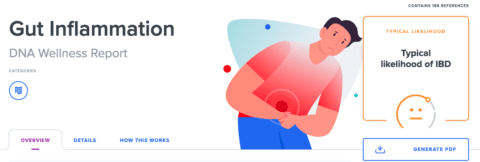
Do you often feel bloated or have abdominal pain or wonder, what does lactose intolerance feel like? Read on to learn more symptoms and what could be causing your problems.
What is lactose intolerance?
Humans owe their ability to digest milk to a single enzyme — lactase. In the majority of humans, the levels of lactase drastically drop when they stop breastfeeding, which we know as lactose intolerance.
However, certain mutations allow people to have high levels of lactase and digest milk as adults. This is known as lactase tolerance. It’s frequent in people of European descent, but can also be found in lower frequencies around the world.
What causes lactose intolerance?
There are actually four types of lactose intolerance.
Primary lactose intolerance, which is a natural response to aging is the most common form of lactose intolerance. Typically babies are born with the enzyme lactase which they use to digest milk from their mother, however the amount of lactase a person produces decreases over time as they rely less on milk from a dietary perspective. This form of lactose intolerance is most common in people of Asian, African, and Hispanic descent.
Secondary lactose intolerance on the other hand is due mostly to disease or injury, like celiac disease or IBD causing your gut to function less optimally.
The third type of lactose intolerance is called congenital lactose intolerance, otherwise known as being born with the condition. This is rare, however in some cases a gene causing lactase to not be made is passed on from their parents. This is normally very apparent as a baby will have diarrhea in response to breast milk, it is important to identify this early as the diarrhea can be life threatening to an infant.
The fourth and final type of lactose intolerance is known as developmental lactose intolerance. This occurs when for instance a baby is born premature, meaning they have yet to begin producing lactase, however typically the baby will go on to develop lactose tolerance.
What does lactose intolerance feel like? Lactose intolerance symptoms
In people who are lactose intolerant, lactose can pass through the gut undigested. But what does lactose intolerance feel like? When gut bacteria ferment lactose, this can also trigger inflammation, and cause unpleasant symptoms, such as:
- Gas
- Bloating
- Abdominal pain
- Diarrhea
Typically these symptoms will begin within 2 hours of eating lactose and will remain until you’ve gotten rid of any lactose from your body.
However, it’s quite possible to be lactose intolerant and not have these symptoms when eating dairy. That’s because many types of dairy don’t contain enough lactose to cause issues.
What foods should you be avoiding if you are lactose intolerant?
Research suggests that people with lactose intolerance can ingest up to 12 – 15 g of lactose without any problems, which is roughly equal to 1 cup of milk. Other dairy products, such as butter, cream, yogurt, and hard cheeses contain much less lactose than that.
You can also eat lactase containing products to improve your digestion of lactose. If you have a more severe intolerance, you’re best off avoiding foods that contain lactose entirely including the following:
- Milk
- Yogurt
- Cream
- Butter
- Cheese
- Ice cream
Make sure you always check the ingredients list of anything you eat keeping a keen eye out for lactose containing constituents like whey, yogurt, dry milk solids, milk powder or curd.
How long do lactose intolerance symptoms last?
You now know what lactose intolerance feels like, but how long do symtoms last? Typically after ingestion, lactose will remain within your digestive system for up to 48 hours. Symptoms may persist for the entire duration that lactose remains in your body.
Lactose intolerance test
The first port of call for your physician to try and identify whether you may be lactose intolerant would typically be an elimination diet. If after elimination lactose from your diet it still remains ambiguous, you may be subjected to a hydrogen breath test.
The hydrogen breath test takes around 2 hours and may cause some gastrointestinal discomfort. You’re first given a drink containing lactose. You then blow up balloon-type bags every 15 minutes for two hours.
The breath trapped within each bag is tested frequently for hydrogen presence, as normally there is very little hydrogen in breath. However, it is produced at higher levels when bacteria break down undigested lactose. Therefore, if you have more hydrogen in your breath, this indicates that you may be struggling to digest lactose and be lactose intolerant.
After the test you can resume your daily life as normal and discuss the results with your medical practitioner.
Another way to test for lactose intolerance is the lactose tolerance test. Your physician will provide you with a drink containing lactose, and your blood will be checked for sugar levels every 30 minutes for 2 hours. If your blood sugar does not rise, it is likely you are incapable of digesting lactose.
You could also test for lactose intolerance at home, by consuming lactose-containing products and keeping an eye out for symptoms.
Genetics and lactose intolerance
Genetics can play a role in how susceptible you are to experiencing lactose intolerance symptoms. Let’s look at the MCM6 gene, for example.
The MCM6 gene encodes a protein required to produce the enzyme that breaks down the milk sugar lactose (lactase). MCM6 mutations are what made adult humans capable of digesting lactose about 5000-8000 years ago.
Some variants of the MCM6 gene have been associated with an increased risk of lactose intolerance, likely through decreased or non-existent enzyme activity.
With lower lactase activity, undigested lactose moves along the digestive tract, it attracts water, making watery diarrhea likely. Once lactose reaches the large intestine, probiotic bacteria ferment it, releasing gas. This leads to bloating, pain, and sluggish digestion.
If you inherit one of these mutations from one parent, you will still maintain some degree of lactose tolerance, however if you inherit two copies of this MCM6 genetic variant from both parents then you’ll be lactose intolerant.
Can I increase lactose tolerance in my body?
There are certain things you can do which may allow you to intake some lactose without experiencing the full effects of lactose intolerance. These include using low-lactose dairy products, taking lactase supplements, and eating other foods alongside lactose-containing foods to reduce the digestive emphasis on the lactose.
Whilst these steps may increase your lactose tolerance, they may not be as effective as treating lactose intolerance at its source, defective genes. Read on to learn more about how you may be able to increase your lactose tolerance by taking steps to counteract any sub-optimal genes you may have.
Can you develop lactose intolerance during adulthood?
It is possible to develop lactose intolerance in adulthood. As previously mentioned, as we age through childhood our lactase levels typically start to decline. Around 65% of people have a lowered lactose tolerance after infancy.
The genetic factors can be equally responsible for lactose intolerance.
So counteracting these and challenging lactose intolerance at its source would be an ideal approach to take.
Your body tends to secrete the enzyme lactase only when instructed to do so by the gene LCT which can get less active over time and result in lactose intolerance.
The condition which can begin as soon as a person turns two years old, may not manifest itself until a person reaches adolescence or adulthood.
The recommended diet for lactose intolerance
Now that you know what lactose intolerance feels like, you might be wondering what steps you can take to minize your symptoms.
If you’re lactose intolerant then more than likely the advice you would receive from a medical expert would simply be to avoid lactose containing foods.
However, by doing this you must be careful to avoid inadvertently causing some forms of malnutrition, as by avoiding dairy products for example you may be at an increased risk of calcium or vitamin D deficiency.
Bearing this in mind, you may want to add some calcium rich foods such as spinach or other leafy greens to your diet and make sure to get a healthy amount of sun exposure. You may also be able to take supplements at your physician’s recommendation.
SelfDecode DNA Reports
The SelfDecode Lactose Intolerance Trait Report analyzes your genetic variants to tell you how likely you are to be intolerant to lactose and offer insights that are personalized to your genes.
One of the most effective ways to identify and take control of your health is to identify whether or not your genes predispose you to any gut-related health issues. As mentioned above, issues such as an inflammatory bowel disease can cause your gut to function suboptimally.
SelfDecode also offers easy to read DNA wellness reports to help you optimize your gut health based on your genes. The Gut Inflammation Report, for example, looks at over 42,900 variants to give your genetic risk score and personalized diet, lifestyle, and supplement recommendations based on your DNA.
Since lactose-containing foods are a common food trigger for gut inflammation, avoiding them can help you improve your symptoms.
Another way to get insights into your health is lab tests. With a membership to SelfDecode, you’ll also receive access to SelfDecode Labs. Just upload your lab test results or purchase a lab test from SelfDecode for health insights about lactose tolerance, for example.
With SelfDecode Labs, you’ll receive a detailed explanation of your markers and lifestyle suggestions based on your test results to help you achieve optimal health.
Conclusion
Generally speaking, you can develop lactose intolerance past infancy, and it is fairly common, as humans owe their ability to digest milk to their ability to breastfeed. However, some individuals, particularly those of European descent, possess genes which allow them to continue consuming lactose throughout their entire lives.
So, what does lactose intolerance feel like? If you do not possess these genes, you’re more likely to experience the symptoms of lactose intolerance such as gas, bloating, abdominal pain and diarrhea following the intake of lactose containing foods. You may be able to identify whether or not you’re lactose intolerant by undertaking a lactose elimination diet or a test such as a hydrogen breath test from your doctor.
Better yet, you can identify your genetic predisposition by using a tool such as SelfDecode, which provides you with expert advice driven by the most up-to-date scientific research. With SelfDecode, you will receive personalized diet, lifestyle, and supplement recommendations based on your DNA and labs.
Related Articles
- FITLabs Review: At-home tests for Food Sensitivities?
- Everlywell Review: Is Food Sensitivity Determined by DNA?
- Gene Food Review: Are DNA and Food Connected?
- Smartblood Review: Blood Testing for Food Intolerances?



